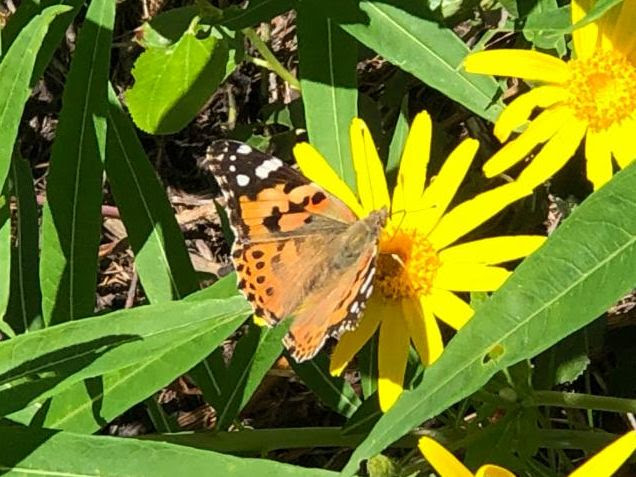Holy Lepidopterans, Batman! It’s a butterfly bonanza! We were inundated with moth and butterfly reports this week, but since this is What’s Buzzin‘, we threw in some buzzing insects for good measure. Summer is just around the corner, and there is no better time to get out and witness the explosion of activity. You won’t even have to look that hard – just step out your front door and you will hear the raucous chorus.

Northern Checkerspot
Chlosyne palla
Checkerspots are generally medium-sized, larger than crescents, and have orange and black checkered uppersides. Their flight is fairly fast, direct and low. They are on the wing in our area from mid June to mid July in a wide variety of habitats, from woodland openings to sagebrush. The males are territorial perchers, often seen in paths or on rocks, and both sexes may be seen feeding on flower nectar, mud, dung, and ash.
Randall Cox, June 10th, 2023. Snowbowl Road, Missoula, MT.
Common Alpine
Erebia epipsodea
It’s a sure sign that spring is well underway when these beautiful butterflies take flight. As the name suggests, this butterfly can thrive at high elevations; they range from as far north as Alaska, south through the Rocky Mountains to northern New Mexico. Within their range, they can be found from moist meadows and prairies to high elevations.
Randall Cox, June 10th, 2023. Snowbowl Road, Missoula, MT.


Milbert’s Tortoiseshell
Aglais milberti
Milbert’s tortoiseshells, along with seven other hardy butterfly species in western Montana, have special “antifreeze chemicals” to survive winter. After literally chilling out for several months, they may be seen flying as early as mid-February on warm, sunny days. By April, they are actively looking for food and mates. With little to no flowers around, they dine on oozing sap, as well as scat and mud for minerals and salt. All told, they can live nine to ten months.
Randall Cox, June 10th, 2023. Snowbowl Road, Missoula, MT.
Common Snakefly
Agulla sp.
Snakeflies look slightly ferocious, and they are; but you only need to worry if you’re a smaller insect. Both larvae and adults are predatory in nature. The larvae somewhat resemble rove beetle grubs, but the adults are unmistakeable with their elongated prothorax. Snakeflies are unique to the western United States; while they do occur globally in temperate conifer forests, in North America you probably won’t find one east of the Rockies.
Morgan McNeill, June 14th, 2023. Lolo, MT.


Digger Bee
Anthophora sp.
With over 450 species in the genus Anthophora, it may not be possible to identify this striking bee to species. As solitary bees, they do not have the backing of a colony to help forage or defend from predators, though some will nest together in aggregations. As their name suggests, these bees nest in the soil, in flat ground or embankments. Their eyes are sometimes pale green, like the individual shown here; a striking diagnostic characteristic.
Randall Cox, June 13th, 2023. Missoula, MT.
Snowberry Checkerspot
Euphydryas chalcedona colon
This checkerspot is so named for it’s larval food source, the snowberry. However, whether or not this species is its own or a subspecies of the variable checkerspot, Euphydryas chalcedona, is up for debate. Some argue that all E. chalcedona north of California should be considered E. colon, but evidence to support these two as separate species is lacking. This species (or subspecies) has a northwestern distribution, from the northern tip of CA into British Columbia, and as far east as Western MT.
Randall Cox, June 10th, 2023. Snowbowl Road, Missoula, MT.


Green Comma
Polygonia faunus
Green Commas join at least 8 other butterfly species in Montana with the distinction of being hardy little insects. Since they can feed on tree sap and minerals from carrion and dung, they are often found flying when snow is still on the ground – well before the first flowers of the season are in bloom. Preferred habitat includes riparian woodlands and wet meadows.
Randall Cox, June 10th, 2023. Snowbowl Road, Missoula, MT.
Yellow-Fronted Bumblebee
Bombus flavifrons
This robust, slightly disheveled-looking bumblebee is widely distributed across the western United States, usually occurring at high elevations. When the queen emerges in early spring, she will often make use of a disused mouse nest to start her colony. This species is often subject to parasitism by the indiscriminate cuckoo bumblebee (Bombus insularis), a parasitic bumblebee species featured in What’s Buzzin’ earlier this year.
Brenna Shea, June 6th, 2023. Missoula, MT.


Painted Lady
Vanessa cardui
Painted ladies are popular as classroom pets, and are often available for purchase as caterpillars so students have the opportunity to observe their life cycle. Their popularity is thanks in large part to their cosmopolitan nature: painted ladies are found in temperate zones on every continent except Antarctica and South America.
Rachel Johnson, June 6th, 2023. Morrell Falls National Recreation Trail, MT.
Western Conifer Looper
Caripeta aequaliaria
Often referred to as the Indian blanket moth or red girdle, this looper moth is found in both coastal and mountainous conifer forests from British Columbia to California, east to Texas, north to Alberta. Their larvae take on two distinct morphs: the more common morph ranges from dark brown to pale gray; the less common morph appears rusty brown with a broken yellow stripe running down it’s back and prominent yellow spots on the side.
Judith Dammel, June 11th, 2023. Evaro, MT.


White Satin Moth
Leucoma salicis
Beautiful both in their immature and adult forms, satin moths were introduced from Europe in 1920 and can now be found across Canada and in the northwestern and northeastern states. Caterpillars eat aspen, poplar (both Populus spp.) and willow (Salix) and can be a forest pest species.
Judith Dammel, June 11th, 2023. Evaro, MT.
Header photo: Modest Sphinx (Pachysphinx modesta) Kristi DuBois, June 10th, 2023. Missoula, MT.